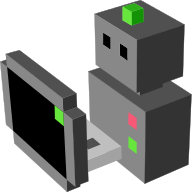Collision¶
Detect objects colliding with the current object.
Sensor to detect objects colliding with the current object.
It allows to select which objects are sensed for collision by setting
the property only_objects_with_property (see the Examples section for
an example).
This sensor is a wrapper around Blender’s own Collision sensor.
Configuration parameters for Collision¶
You can set these properties in your scripts with <component>.properties(<property1>=..., <property2>=...).
only_objects_with_property(string, default:"")- Only report collision with objects that have this property, default “” (all objects)
Data fields¶
This sensor exports these datafields at each simulation step:
timestamp(float, initial value:0.0)- number of seconds in simulated time
collision(bool, initial value:False)- objects colliding with the current object
Interface support:
(attention, no interface support!)
Services for Collision¶
get_configurations()(blocking)Returns the configurations of a component (parsed from the properties).
Return value
a dictionary of the current component’s configurations
get_local_data()(blocking)Returns the current data stored in the sensor.
Return value
a dictionary of the current sensor’s data
get_properties()(blocking)Returns the properties of a component.
Return value
a dictionary of the current component’s properties
set_property(prop_name, prop_val)(blocking)Modify one property on a component
Parameters
prop_name: the name of the property to modify (as shown the documentation)prop_val: the new value of the property. Note that there is no checking about the type of the value so be careful
Return value
nothing
Examples¶
The following examples show how to use this component in a Builder script:
from morse.builder import *
# adds a default robot (the MORSE mascott!)
robot = Morsy()
# create and add a Collision sensor
collision = Collision()
# place it on the front side of the robot
collision.translate(0.43,0,0.3)
# only detect collision with objects which have the property 'Object'.
# see the documentation of `Passive Objects` for details:
# http://www.openrobots.org/morse/doc/latest/user/others/passive_objects.html
collision.properties(only_objects_with_property="Object")
robot.append(collision)
# for this example, we use the socket interface
collision.add_interface("socket")
# we also add a keyboard actuator to be able to move
# around our robot to test collisions
keyboard = Keyboard()
robot.append(keyboard)
# the 'sandbox' test environment offers plenty of objects to test
# collisions. These objects have all the property 'Object' already set.
env = Environment('sandbox')
# Copy this code to a script, and run it with `morse run <script>`!
# This is a sample *client* code that uses pymorse to count the
# collisions. Copy this code to a different script, start it with
# `python3 <script>`, and move the robot in the simulator with the
# arrow keys: when you collide with an object, it is printed on the
# console.
import pymorse
nb_collisions = 0
def counter(data):
global nb_collisions
if data["collision"]:
nb_collisions += 1
print("Collision with %s! In total, %d collisions occured" % (data["objects"], nb_collisions))
with pymorse.Morse() as morse:
morse.robot.collision.subscribe(counter)
print("Press ctrl+C to stop")
while True:
morse.sleep(10)
Other sources of examples¶
(This page has been auto-generated from MORSE module morse.sensors.collision.)
